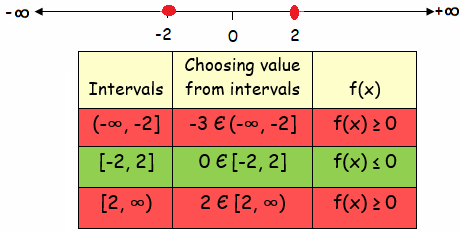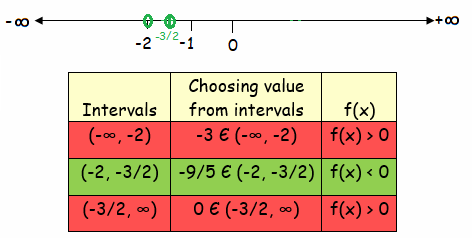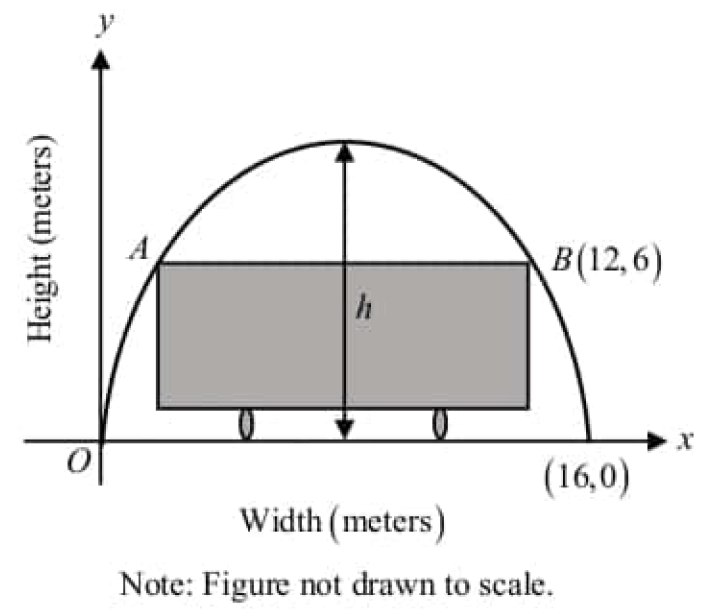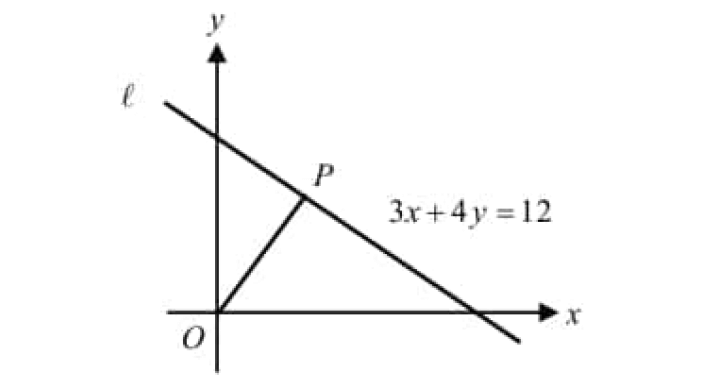EXAMPLES OF SOLVING QUADRATIC INEQUALITIES
How to solve Quadratic inequalities :
The standard forms of quadratic inequalities are below
- ax2 + bx + c > 0
- ax2 + bx + c < 0
- ax2 + bx + c ≥ 0
- ax2 + bx + c ≤ 0
Step 1 :
Solve the quadratic equation by the factorization method.
Step 2 :
We solved the x values from step 1. These values are known as critical numbers.
Step 3 :
By applying the x values on a number line, we find the intervals.
Step 4 :
We will choose random values from intervals and apply the given function.
If f(x) is being satisfied by the values we choose from the interval, then that interval or intervals are known as the solution.
Solve for x :
Example 1 :
3x2 ≤ 12
Solution :
3x2 ≤ 12
Subtract 12 on both sides, we get
3x2 - 12 ≤ 12 – 12
3x2 - 12 ≤ 0
Let f(x) ≤ 0
3x2 – 12 = 0
3x2 = 12
x2 = 4
So, x = 2 and x = -2 (critical numbers)
The critical numbers are dividing the number line into three intervals.

From the table, the possible values of x are
-2 ≤ x ≤ 2
By writing it as interval notation, we get
[-2, 2]
So, the required solution is -2 ≤ x ≤ 2
Example 2 :
x2 – 4x + 4 < 0
Solution :
Let f(x) = x2 – 4x + 4
f(x) < 0
x2 – 4x + 4 < 0
By factorization, we get
x2 – 2x(2) + 22 < 0
(x-2)2 < 0
For any values of x, f(x) will not give negative value. So the solution is all real values.
Example 3 :
2x2 + 7x < -6
Solution :
2x2 + 7x < -6
Add 6 on both sides, we get
2x2 + 7x + 6 < -6 + 6
2x2 + 7x + 6 < 0
Let f(x) = 2x2 + 7x + 6
f(x) < 0
2x2 + 7x + 6 < 0
By factorization, we get
(2x + 3) (x + 2) = 0
x = -3/2 and x = -2 (critical numbers)

From the table, the possible values of x are
-2 < x < -3/2
By writing it as interval notation, we get
(-2, -3/2)
So, the required solution is -2 < x < -3/2
Example 4 :
x2 + 6x + 8 < 0
Solution :
x2 + 6x + 8 < 0
x2 + 2x + 4x + 8 < 0
x(x + 2) + 4(x + 2) < 0
(x + 4)(x + 2) < 0
Getting critical numbers,
x + 4 = 0 and x + 2 = 0
x = -4 and x = -2
Decomposing into intervals, we get
(-∞, -4) (-4, -2) and (-2, ∞)
f(x) = (x + 4)(x + 2) < 0
Applying one of the value from the interval (-∞, -4)
Let x = -5
f(-5) = (-5 + 4)(-5 + 2)
= -1(-3)
= 3 < 0
It is false. (-∞, -4) is not a solution.
Applying one of the value from the interval (-4, -2)
Let x = -3
f(-3) = (-3 + 4)(-3 + 2)
= 1(-1)
= -1 < 0
It is true. (-4, -2) is a solution.
Applying one of the value from the interval (-2, ∞)
Let x = 0
f(0) = (0 + 4)(0 + 2)
= 4(2)
= 8 < 0
It is false. Then, (-2, ∞) is not a solution.
So, the required solution is -4 ≤ x ≤ -2.
Example 5 :
When a baseball is hit by a batter, the height of the ball, ℎ(𝑡), at time 𝑡, is determined by the equation
ℎ(𝑡) = −16𝑡2 + 64𝑡 + 4
For which interval of time is the height of the ball greater than or equal to 52 feet?
Solution :
Given condition is when the height will be ≥ 52
−16𝑡2 + 64𝑡 + 4 ≥ 52
−16𝑡2 + 64𝑡 + 4 - 52 ≥ 0
−16𝑡2 + 64𝑡 - 48 ≥ 0
Dividing by -16, we get
𝑡2 - 4𝑡 + 3 ≤ 0
(t - 1)(t - 3) ≤ 0
Finding the critical numbers, we get
t = 1 and t = 3
Decomposing into intervals, we get
(-∞, 1) (1, 3) and (3, ∞)
Applying one of the value from the interval (-∞, 1)
Let x = 0
f(0) = (0 - 1)(0 - 3)
= 3
It is false, then (-∞, 1) is not a solution.
Applying one of the value from the interval (1, 3)
Let x = 2
f(2) = (2 - 1)(2 - 3)
= -1
It is true, then (1, 3) is a solution.
Applying one of the value from the interval (3, ∞)
Let x = 4
f(4) = (4 - 1)(4 - 3)
= 3(1)
= 3
Then the required solution is 1 < x < 3.
Example 6 :
The surface area, A, of a cylinder with radius r is given by the formula 𝐴 = 2𝑟2 − 5𝑟. What possible radii would result in an area that is greater than 12 cm2 ?
Solution :
A = 2𝑟2 − 5𝑟
The required area should be greater than 12, then
2𝑟2 − 5𝑟 > 12
2𝑟2 − 5𝑟 - 12 > 0
2𝑟2 − 8𝑟 + 3r - 12 > 0
2r(r - 4) + 3(r - 4) > 0
(2r + 3)(r - 4) > 0
Finding critical number, we get
r = -3/2 and r = 4
Here negative value is not possible for radius, then the required radius should be greater than 4.
Example 7 :
When a projectile is fired into the air, its height h, in metres, t seconds later is given by the equation
ℎ(𝑡) = 11𝑡 − 3𝑡2
When is the projectile at least 6 m above the ground?
Solution :
The given condition is that the height is atleast 6 m, then
11𝑡 − 3𝑡2 > 6
− 3𝑡2 + 11t - 6 > 0
Multiply by negative, we get
3𝑡2 - 11t + 6 < 0
3𝑡2 - 2t - 9t + 6 < 0
t(3t - 2) - 3(3t - 2) < 0
(t - 3)(3t - 2) < 0
t = 3 and t = 2/3
So, the required solution is 2/3 < t < 3.
Kindly mail your feedback to v4formath@gmail.com
We always appreciate your feedback.
©All rights reserved. onlinemath4all.com
Recent Articles
-
Digital SAT Math Problems and Solutions (Part - 242)
Aug 03, 25 08:34 PM
Digital SAT Math Problems and Solutions (Part - 242) -
Digital SAT Math Problems and Solutions (Part - 241)
Aug 02, 25 11:09 AM
Digital SAT Math Problems and Solutions (Part - 241) -
Digital SAT Math Problems and Solutions (Part 240)
Aug 02, 25 02:42 AM
Digital SAT Math Problems and Solutions (Part 240)

